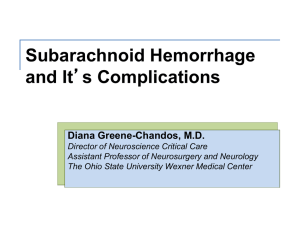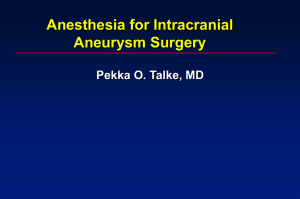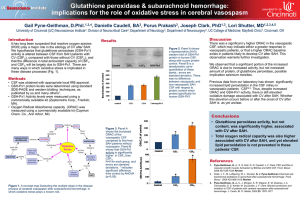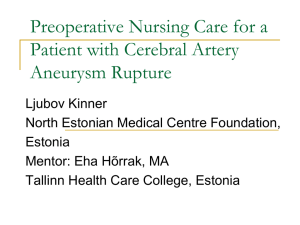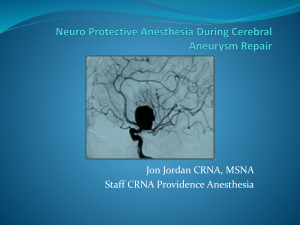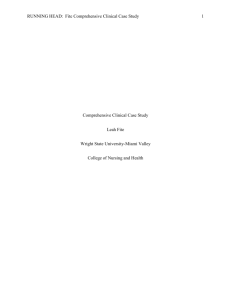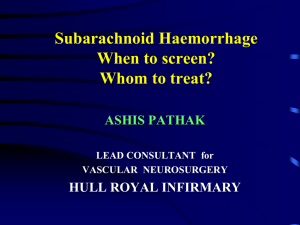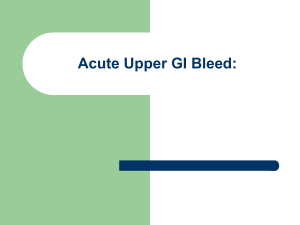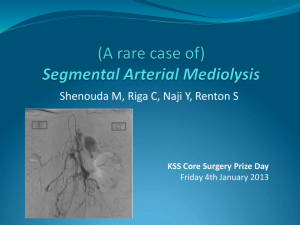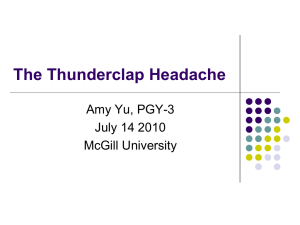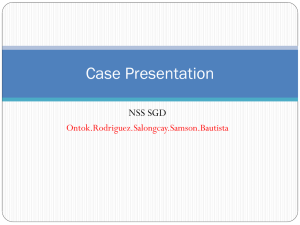Subarachnoid Haemorrhage
advertisement
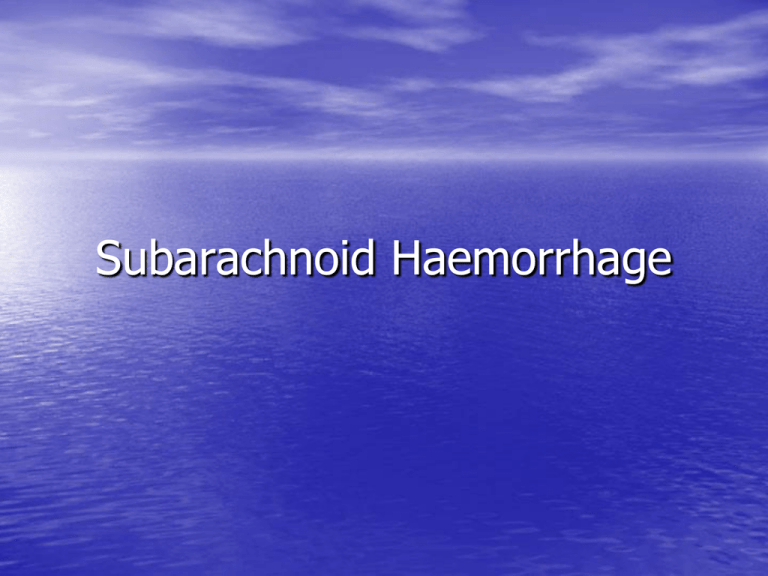
Subarachnoid Haemorrhage SAH • What is it? – Bleeding into the subarachnoid space (space between the pia & arachnoid meningeal layers) where blood vessels lie & CSF flows • Where does the blood come from? – An aneursym on a blood vessel in the subarachnoid space has ruptured (~70%) – Unknown (~15%) – AVM (~10%) – Rare causes (e.g. tumour) (~5%) • Where does the blood go? – Anywhere where CSF goes, may get hydrocephalus if into ventricle & causes obstruction of CSF circulation SAH • Incidence = 1/7000 people • Higher chance if: – Female – 3rd trimester of pregnancy – Middle-aged – Abuse of stimulant drugs – Connective tissue disorder – Family history – PCKD What causes aneurysms to form? • Defects in the media of the arteries • Defects are thought to expand as a result of hydrostatic pressure from pulsatile blood flow and blood turbulence, which is greatest at the arterial bifurcations What causes aneurysms to rupture? • The probability of rupture is related to the tension on the aneurysm wall • The law of La Place states that tension is determined by the radius of the aneurysm and the pressure gradient across the wall of the aneurysm • Therefore, the rate of rupture is directly related to the size of the aneurysm • Aneurysms with a diameter of 5 mm or less have a 2% risk of rupture, whereas 40% of those 6-10 mm have already ruptured upon diagnosis SAH – The Problem • They occur in young people – 80% in 40-65 year olds – 15% in 20-40 year olds • It can kill quickly – 25% die within 24 hours – 50% will be dead at 6 months • It causes significant disability – Cognitive impairment – Neurological disability depending on size of bleed & complications encountered How do they present? • Headache – sudden onset & severe – small leak may cause minor headache & may be warning sign of rupture • Reduced consciousness • Meningism – Vomiting – Neck stiffness – Photophobia • Seizures What causes symptoms & signs? • Blood leaking from the aneurysm • Local pressure effects of the aneurysm • Associated ICH • Emboli What causes symptoms & signs? • Blood leaking from the aneurysm – Headache – Meningism What causes symptoms & signs? • Local pressure effects of the aneurysm – Acom • Visual symptoms due to optic chiasm compression • Positive babinski • Bilateral lower limb paresis – MCA • Contralateral hand & face paresis • Contralateral visual neglect • Aphasia (dominant side) – ICA/Pcom • CNIII signs What causes symptoms & signs? • Associated ICH – The aneurysm usually lies within the subarachnoid cisterns – It can become adherent to adjacent brain due to adhesions (e.g. from a previous leak) – The bleed therefore can also extend into the brain • MCA = TL causing hemiparesis & aphasia (if dominant) • Acom = mutism – AVM is more likely to cause ICH as they usually lie somewhat in brain parenchyma Headache • A sudden onset severe headache IS caused by a SAH until you have done investigations which prove otherwise Sudden onset severe headache ABCs History – ask about anticoagulants Routine bloods & coag & group & screen IV access Non-sedating analgesia & hold any anticoagulants Blood on CT = SAH CT brain noncontrast Investigations Keep fasting Examination Is there any other pathology on CT? Where is the aneurysm? CT COW +/cerbral angiogram For angiogram & coiling if suitable For craniotomy & clipping if not suitable for coiling Ensure pre-op ready – consent, G&S, check bloods, fasting Monitor GCS for any changes from admission examination Meanwhile chart nimodipne, fluids, anti-seizure medication Sudden onset severe headache ABCs Routine bloods & coag & group & screen IV access Non-sedating analgesia & hold any anticoagulants No blood on CT scan CT brain noncontrast Investigations Keep fasting Examination Is there any other pathology on CT? Lumbar puncture LP = positive for SAH Diagnosis still uncertain CT COW +/cerbral angiogram May repeat cerebral angio No aneurysm History – ask about anticoagulants Investigations • CT scan without contrast • Lumbar puncture • CT COW • Cerebral angiogram • MRI/MRA 98% sensitive @ 12 hours 80% at day 3 50% at day 7 Also good to see if any associated ICH or hydrocephalus. May help localise the location of the aneurysm if there is more than 1 & may also see AVM Where is the aneurysm? • Where is the blood on the CT scan? – Basal cisterns – COW aneurysm – Sylvian fissure – ICA, Pcom, MCA – Interhemispheric or intraparenchymal - Acom • A cistern where the arachnoid extends across between the two temporal lobes, and encloses the cerebral peduncles including the structures contained in the interpeduncular fossa. MCA stroke - Emergency neuroradiology. Axial CT scan at the level of the basal cisterns shows the "hyperdense middle cerebral artery (MCA) sign" (arrow) representing acute clot within the right middle cerebral artery, accounting for the patient's clinical symptoms SAH & LP • CT & LP are critical to diagnosing SAH • No need for LP if obvious blood in subarachnoid space on CT • Blood may not be evident on CT, especially if it is performed > few days after bleed • LP should only be performed after 12 hours of headache onset SAH & LP • When blood enters the CSF (e.g. from SAH or during LP) the red cells are broken down & oxyhaemoglobin is released • It then takes 12 hours for the oxyhaemoglobin to be converted into bilirubin – conversion is via an enzyme found in the brain. • Bilirubin in the CSF, therefore, tells us that blood must have been in the subarachnoid space for at least 12 hours • Blood which entered the CSF during the LP would not encounter the enzyme & could not produce bilirubin • The CSF will look xanthochromic (yellowish discolouration) if bilirubin is present which they will look for with spectroscopy in the lab What may I find on examination? • Normal exam • Confusion/memory loss • Aphasia • CN abnormalites – CNII – papilloedema, usually mild initially & retinal haemorrhages – CNIII – palsy • Hemiparesis/neglect • Obs – HTN, tachycardic, febrile Treatment • Main aim is damage control – want to prevent further bleeding & try to avoid the complications that SAH patients get • SAH patients will vary greatly from GCS 15/15 to GCS 3/15 To coil or clip? • Coiling – Endovascular technique done in angiography by interventional radiologists under GA – May be best if small necked aneurysm – Used in particularly sensitive areas e.g. basilar tip – Must be able to access the aneurysm (e.g. any stenosis or tortuous vessels) – Like dome:neck ratio to be 2:1 or greater • Clipping – Craniotomy & careful dissection using microscope to reach aneurysm & clip usually at neck – May be performed after failed clipping – If aneurysm can’t be reached by the endovascular root That’s Dandy • First to clip an aneursym successfully in 1937 • Walter Dandy Operative microscope • Complications with SAH 1. Re-bleeding 2. Hydrocephalus 3. Vasospasm 4. Hyponatraemia 5. Seizures 6. VTE Complications with SAH • Re-bleeding – 80% mortality if re-bleed – Greatest risk is in the first 24 hours after the initial bleed – Aim to prevent by controlling BP to avoid dramatic changes & isolate the aneurysm from the circulation (coil or clip) Complications with SAH • Hydrocephalus – Obstructive • Blood enters the ventricles & can block the flow of CSF e.g. at the aqueduct or outlet of the 4th ventricle – Communicating • Due to blood blocking reabsorption of CSF through the arachnoid granules – May need an extraventricular drain to treat – Keep head of bed at 300 (promote CSF flow & venous return) Complications with SAH • Vasospasm – Blood vessel goes into spasm causing ischaemia - stroke – To prevent keep them filled with at least 3L fluid day & nimodipine IV/PO & insert central line to monitor central venous pressure – aiming for 8-10 – Suspected with deteriorating GCS/new neurological deficit – Treatment – Urgent CT brain to rule out a bleed as a cause of the deterioration then urgent angiogram to diagnose & treat vasospasm – Greatest risk of vasospasm is days 4-7 but significant risk for first 3 weeks after bleed, therefore will use preventative measures for at least 3 weeks Complications with SAH • Hyponatraemia – Susceptible due to being fluid loaded & cerebral salt wasting – Cerebral salt wasting = renal loss of sodium due to intracranial pathology ? Cause. Loss of water & salt (whereas SIADH is loss of salt & retention of water) – Treat with normal or hypertonic saline – If refractory may need a mineralocorticoid e.g. fludrocortisone to stimulate renal reabsorption – but this should only be used under instructions from consultant endocrinologist Complications with SAH • Seizures – A seizure is a disturbance of sensation, movement or consciousness – All seizures originate from the surface of the brain – cortex – Blood is an irritant to the cortex – Prophylaxis with phenytoin or levetiracetam – Ensure phenytoin levels are therapeutic – Treat as seizure from any cause & suspect re-bleed Complications with SAH • VTE – On bed rest – TEDS – Prophylactic enoxaparin as soon as consultant sees fit – Always keep VTE in the back of your mind How are SAH graded? World Federation Neurosurgeons Fischer grading GCS 15, only Grade 1 CN deficit if any GCS 13-14, no Grade 2 deficit GCS 13-14, with Grade 3 deficit GCS 7-12, +/- Grade 4 deficit GCS 3-6 +/deficit Grade 5 No blood Diffuse blood, no clots & <1mm Clots & blood 1mm or more ICH or intraventricular clots Subdural Haematoma Extra-dural haematoma Extra-dural haemtoma Intra-parenchymal haematoma
